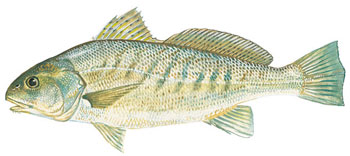 Ovaries in Atlantic croaker are smaller if the fish are found in the Dead Zone's hypoxic waters.
Ovaries in Atlantic croaker are smaller if the fish are found in the Dead Zone's hypoxic waters.  Female croaker were found to produce sperm in hypoxic water.
Female croaker were found to produce sperm in hypoxic water.
AUSTIN, Texas—Atlantic croaker living in the large Gulf of Mexico “Dead Zone” exhibit severe reproductive impairment with potential long-term impacts on the fish’s population abundance, researchers from The University of Texas at Austin’s Marine Science Institute found.
Both males and females were found to produce dramatically fewer sperm and eggs. In addition, females in the hypoxic Dead Zone waters were masculinized—some 20 percent actually produced sperm in their ovaries. The sex ratio was also heavily skewed toward males in the hypoxic area.
“This is the first evidence of impairment of reproductive output across a wide region in a fish population inhabiting a hypoxic coastal zone,” says Peter Thomas, professor of marine science.
Thomas and his coauthor, Md. Saydur Rahman, published their research in Proceedings of the Royal Society B.
The occurrence of low oxygen (hypoxic) waters in coastal regions worldwide has increased dramatically over the past 25 years, but its impacts on marine animals are just beginning to be understood.
The northern Gulf of Mexico “Dead Zone,” off the coast of Louisiana, is the second largest seasonal hypoxic zone in the world, averaging 6,447-square-miles in size annually. Coastal areas affected by hypoxia are often economically and environmentally important for maintaining fish populations and fisheries.
Thomas and Rahman collected and studied fish from sites throughout the northern Gulf of Mexico hypoxic zone and compared them with fish collected from areas with normal oxygen levels.
Masculinization of the female croaker and other reproductive problems were associated with declines in neuroendocrine function and ovarian and brain expression of an enzyme called aromatase that converts androgens (male sex hormones) to estrogens (female sex hormones). This was found to be the case in both field and laboratory experiments.
“Our results show that ovarian masculinization is a specific response to hypoxia and is due to decreased aromatase activity,” says Thomas.
Contact: Peter Thomas, peter.thomas@mail.utexas.edu, 361-749-6768
Main Page Photo Credit: SEFSC Pascagoula Laboratory; Collection of Brandi Noble, NOAA/NMFS/SEFSC.

















Comments 2
A nice piece of data! Congratulations Drs. Rahman and Thomas! I am wondering if this effect is mediated via epigenetic mechanisms as environmental factors adversely affect genome stability through epigenetic modifications. I guess a whole genome analysis of DNA methylation and Histone modifications in specific gonadal germ and somatic cells of individuals from hypoxic and non-hypoxic conditions would reveal how many pathways are being altered by hypoxia. As these approaches are upstream of transcriptional regulation, genomic microarray of those specific cell samples would probably help correlate gene expression with epigenome. One shot of experiment would reveal everything required for understanding dead zone effects on croaker reproduction at the molecular level.
Goodluck!
This is a topic that is near to my heart... Cheers! Where are your contact details though?